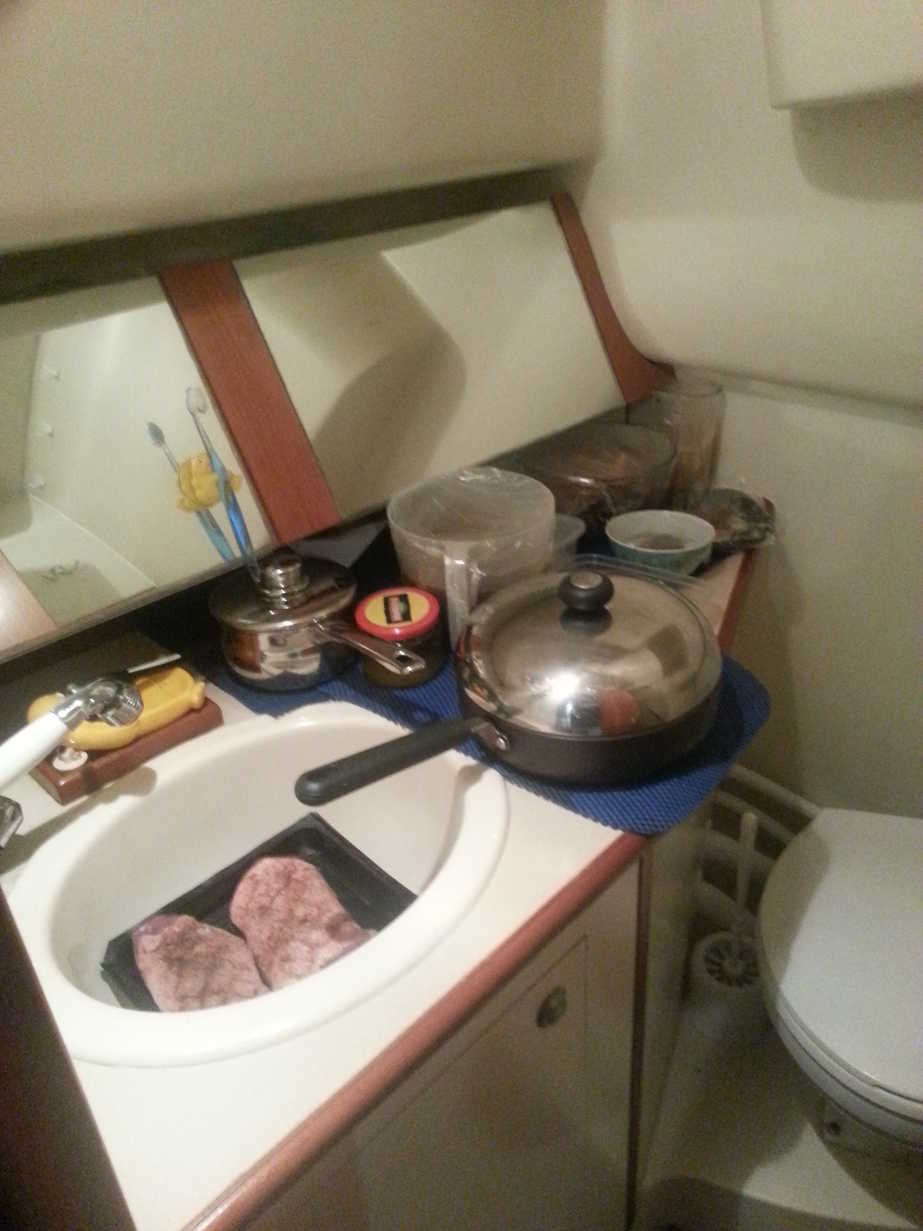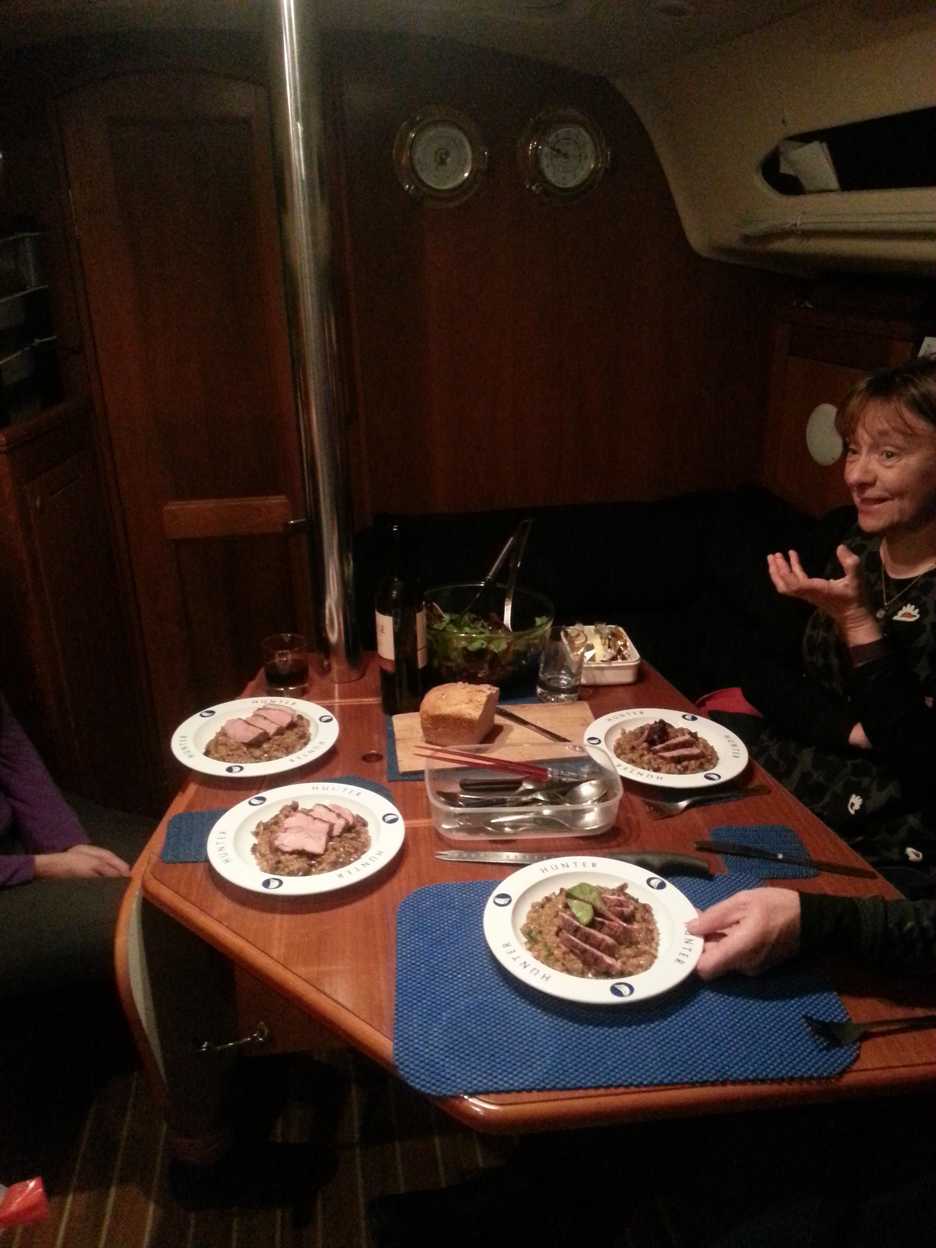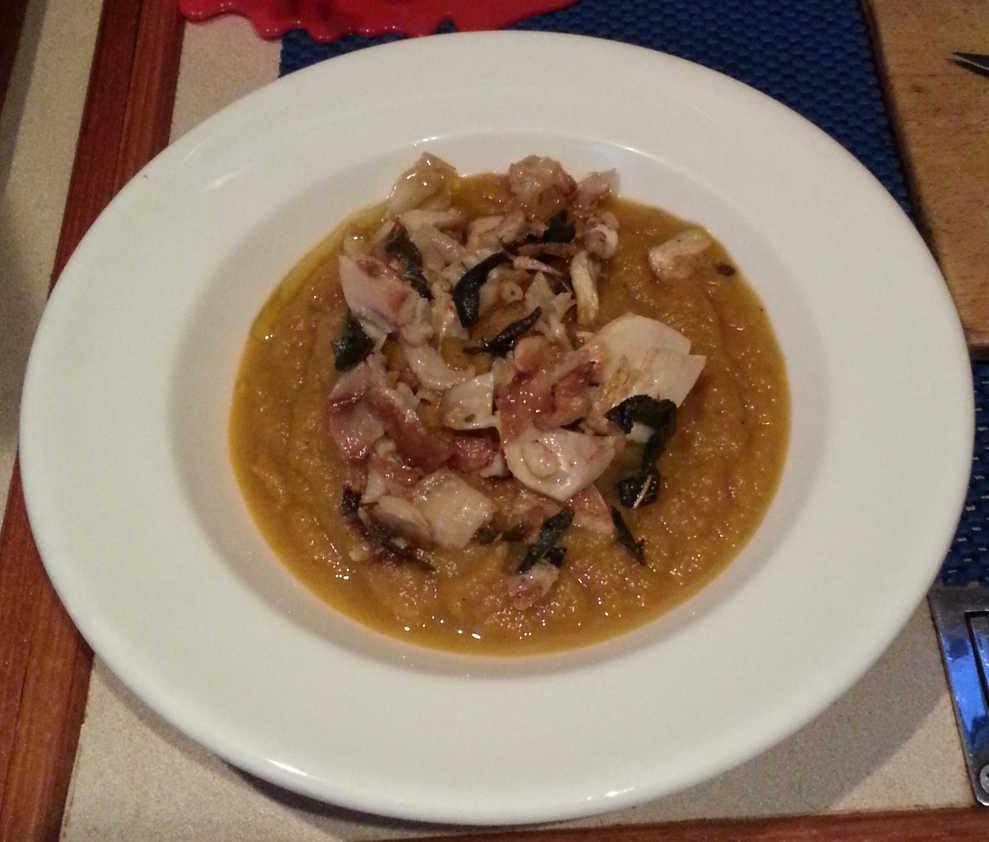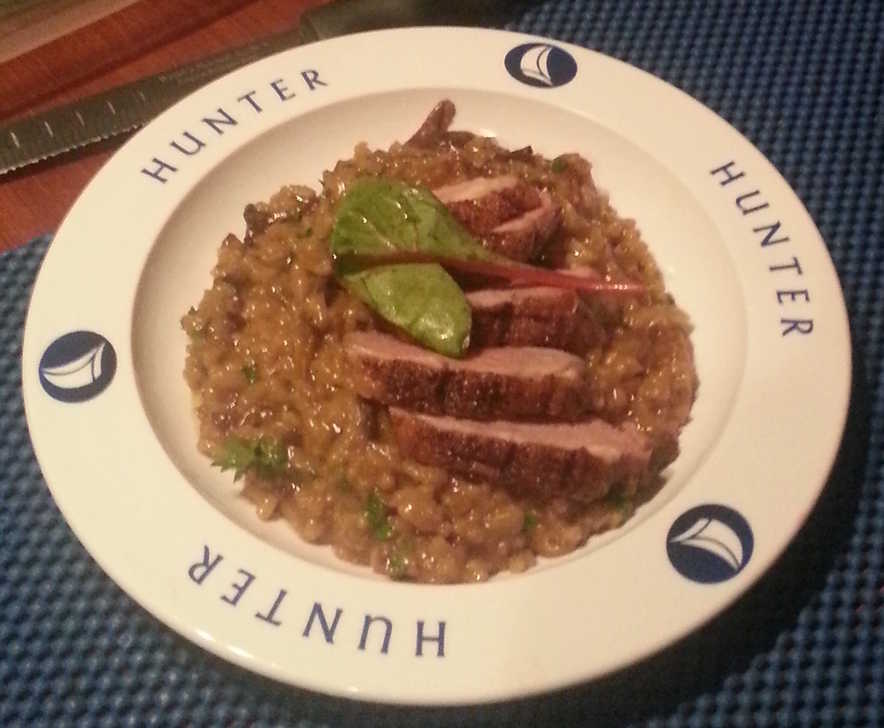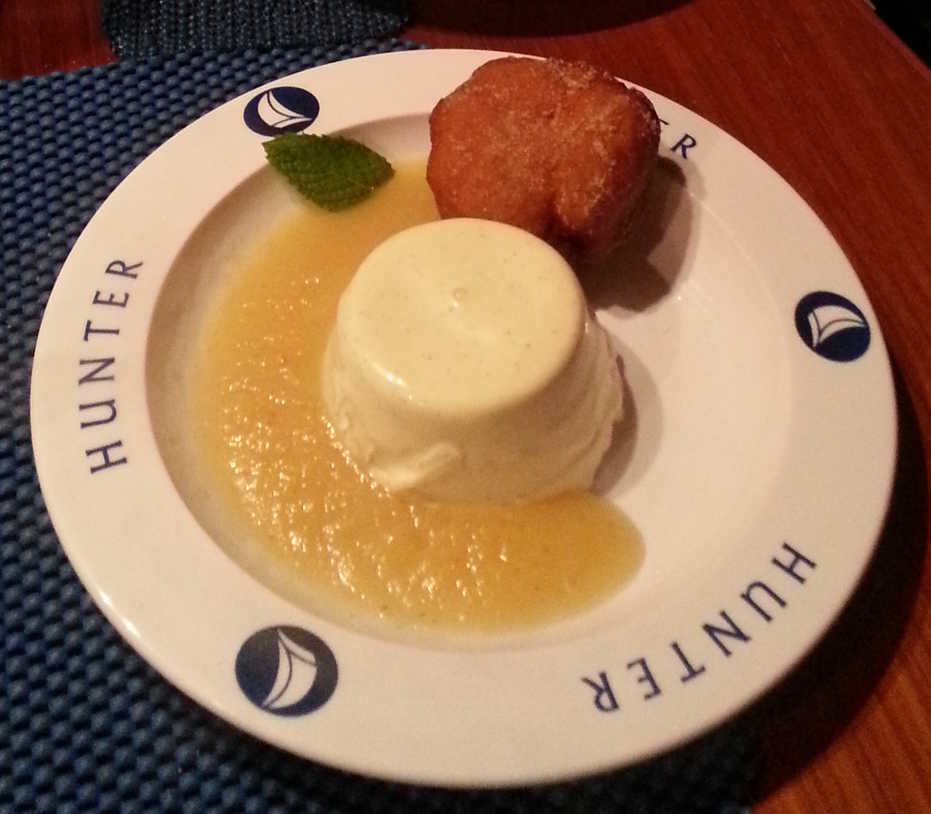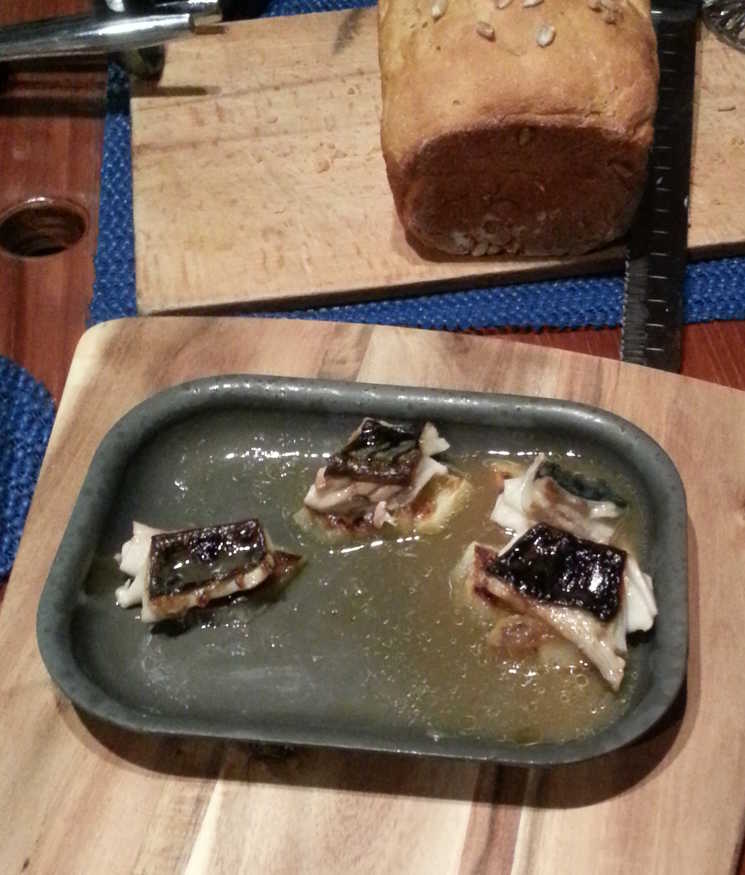
My First Boat Dinner

My first dinner party cooked aboard Harmony. Quite the mammoth undertaking, if I'm honest.
It took two solid days of shopping and prepping, but it passed off very well I thought.
Since I now have only one (or none) of everything, it's difficult to multitask, so all the preparation and cooking has to more-or-less happen in strict sequence.
Not only that, but each task is now burdened by a ludicrous overhead - I can no longer open a cupboard and remove a pan, for example. If I want that pan I have to pull out the velcroed seat cushion and store it securely, hoist the back-rest cushions, raise the under-seating-storage lid and secure it behind the back-rest. Then I lift out the top layer of pots in its plastic tub, set it securely to one side, retrieve the pan I require, restore the plastic tub, raise the back-rest so as to lower the storage lid, then return the seat cushion. At this point I usually realise that I have forgotten the pan lid.
Rinse and repeat. For every. Single. Utensil.
Space aboard a 30-foot yacht is also a bit tight for entertaining, so I may have had to use the heads as a staging area, but the room was spotless, since I'd had to replace the pump mechanism and clean up all the resultant spillage.
Clean as a kitchen. Honest.
South Queensferry (where I now live, for the time being) seems ill-served by food shops, like butchers, bakers, greengrocers or fishmongers. Or candlestickmakers for that matter. Oh wait, now I think about it, it might actually have one of those! It does, however, sport both a Scotmid and a Tesco.
Thus is it blessed.
I had heard rumours of a mobile fishmonger's van which I tracked down on Thursday morning parked outside Scotmid, but it was a great deal smaller than I'd imagined and though it had some attractive salmon, it had no mackerel. So I was forced to fall back on Tesco, who provided their usual old, tired, fish that served. Just.
I was able to prepare most everything ahead of time, with really only the risotto to take up any party time - and I had the mackerel to keep the guests' bouches amused while I cooked that.
There's not much I could have done better or differently, except that I didn't really fry the sage leaves for dressing the soup well enough to crisp. Prompting Aidan's question What's the greenery? - asked in the tones of an Irishman unfamiliar with vegetables in general, and herbs in particular.
It took two solid days of shopping and prepping, but it passed off very well I thought.
Since I now have only one (or none) of everything, it's difficult to multitask, so all the preparation and cooking has to more-or-less happen in strict sequence.
Not only that, but each task is now burdened by a ludicrous overhead - I can no longer open a cupboard and remove a pan, for example. If I want that pan I have to pull out the velcroed seat cushion and store it securely, hoist the back-rest cushions, raise the under-seating-storage lid and secure it behind the back-rest. Then I lift out the top layer of pots in its plastic tub, set it securely to one side, retrieve the pan I require, restore the plastic tub, raise the back-rest so as to lower the storage lid, then return the seat cushion. At this point I usually realise that I have forgotten the pan lid.
Rinse and repeat. For every. Single. Utensil.
Space aboard a 30-foot yacht is also a bit tight for entertaining, so I may have had to use the heads as a staging area, but the room was spotless, since I'd had to replace the pump mechanism and clean up all the resultant spillage.
Clean as a kitchen. Honest.
South Queensferry (where I now live, for the time being) seems ill-served by food shops, like butchers, bakers, greengrocers or fishmongers. Or candlestickmakers for that matter. Oh wait, now I think about it, it might actually have one of those! It does, however, sport both a Scotmid and a Tesco.
Thus is it blessed.
I had heard rumours of a mobile fishmonger's van which I tracked down on Thursday morning parked outside Scotmid, but it was a great deal smaller than I'd imagined and though it had some attractive salmon, it had no mackerel. So I was forced to fall back on Tesco, who provided their usual old, tired, fish that served. Just.
I was able to prepare most everything ahead of time, with really only the risotto to take up any party time - and I had the mackerel to keep the guests' bouches amused while I cooked that.
There's not much I could have done better or differently, except that I didn't really fry the sage leaves for dressing the soup well enough to crisp. Prompting Aidan's question What's the greenery? - asked in the tones of an Irishman unfamiliar with vegetables in general, and herbs in particular.
menu
Sundries
Wholemeal Boat Bread
Starter
Pumpkin and Apple Soup
Main Course
Wild Mushroom Risotto
Dessert
Poire Williams Panna Cotta
Wholemeal Boat Bread
With sunflower seeds!
Grilled Mackerel with Apple and Yuzu
To amuse the bouche.
Starter
Pumpkin and Apple Soup
A pumpkin soup, just for old time's sake.
Decorated with sage chicken.
Main Course
Wild Mushroom Risotto
Topped with cocoa-dusted duck breasts.
Chic's Salad
With an un-smoky whisky dressing.
Dessert
Poire Williams Panna Cotta
Served with hot buttered pear purée and ginger doughnuts.
Chic's Whisky Salad
salad nautical veg vegan
My friend Chic served up a tasty salad with a dressing made using a very smoky whisky.
Unfortunately my whisky was nowhere near smoky enough to reproduce the effect.
I also threw in some yuzu and orange juice, but I don't think it helped.
I also threw in some yuzu and orange juice, but I don't think it helped.
Ingredients
- mixed lettuce leaves
- tomatoes
- cooked beetroot
- dates
- mixed seeds
For the dressing:- olive oil
- balsamic vinegar
- crushed garlic
- smoky whisky
- smoked paprika perhaps
- salt & pepper
Chop the salad.
Mix the dressing.
Throw in a few seeds.
Dress.
Serve.
Mix the dressing.
Throw in a few seeds.
Dress.
Serve.
An intriguing flavour - when I first tried it I thought the dates had been smoked.
Pumpkin and Apple Soup with Sage Chicken
soup fowl nautical
Well, having an autumnal pumpkin feast is a tradition with me, it seemed a shame to miss out on the gourds completely.
I started making this with 2 Braeburn apples, but only ended up blending in about 1 apple's worth. Two seemed like it would have been too much.
I went for the sweeter Braeburn, but perhaps a baking apple (Granny Smith/Bramley) would have worked better?
If you roast a chicken to make fresh stock, you'll be able to use the breasts to dress the soup.
I started making this with 2 Braeburn apples, but only ended up blending in about 1 apple's worth. Two seemed like it would have been too much.
I went for the sweeter Braeburn, but perhaps a baking apple (Granny Smith/Bramley) would have worked better?
If you roast a chicken to make fresh stock, you'll be able to use the breasts to dress the soup.
Serves 6
Ingredients
- a small culinary pumpkin - about 500g/1lb skinned, seeded and cubed
- olive oil
- 2 onions, peeled and chopped
- 2 cloves garlic, peeled and crushed
- 1-2 carrots
- 1 Braeburn apple, peeled, cored, chopped
- 570ml/1 pint chicken stock
- 300ml/½ pint dry cider or apple juice
- a dozen sage leaves
- salt and freshly ground pepper
To Serve:- fruity olive oil
- two dozen small sage leaves
- 2 boneless chicken breasts (or thighs), skin on, chopped into pieces
Cut the pumpkin into quarters, de-seed, brush the flesh with olive oil and roast at 180°C/350°F/Gas Mark 4
until soft and ready to separate from the skin. Scrape away the flesh while still warm it will be easier and reserve.
Heat the oil in a large saucepan and add the carrots, onions and the garlic. Cook until onions are translucent then add the chopped apples and sage. Cook for another 2 minutes, add the pumpkin, the stock and the cider or apple juice. Bring to the boil and simmer for 15-20 minutes until the ingredients are tender. Remove the sage leaves and liquidise. Season generously with pepper and salt.
Fry small sage leaves in oil until they begin to crisp. Add the chopped chicken and fry until it begins to darken.
Drizzle the soup with a fruity olive oil, decorate with the crisp chicken and sage leaves, and serve piping hot with crusty bread.
Heat the oil in a large saucepan and add the carrots, onions and the garlic. Cook until onions are translucent then add the chopped apples and sage. Cook for another 2 minutes, add the pumpkin, the stock and the cider or apple juice. Bring to the boil and simmer for 15-20 minutes until the ingredients are tender. Remove the sage leaves and liquidise. Season generously with pepper and salt.
Fry small sage leaves in oil until they begin to crisp. Add the chopped chicken and fry until it begins to darken.
Drizzle the soup with a fruity olive oil, decorate with the crisp chicken and sage leaves, and serve piping hot with crusty bread.
A little bland, but not too bad.
It's definitely improved by the addition of the sage chicken. Use small sage leaves, or cut up larger ones. Otherwise your guests will be munching unpleasantly large mouthfuls of sage or greenery.
It's definitely improved by the addition of the sage chicken. Use small sage leaves, or cut up larger ones. Otherwise your guests will be munching unpleasantly large mouthfuls of sage or greenery.
Mackerel Grilled with Apple and Yuzu
fish snack nautical
I had something along these lines as an amuse bouche at Martin Wishart, so I thought I'd give it a go.
Mackerel have a paper thin translucent skin layer covering the iridescent skin underneath. If you peel this layer away it will help to stop the fish curling up when grilled.
Incidentally, Martin tells me that he uses grated apple, rather than apple slices, which avoids the need to grill the apple first. But actually, I rather liked the caramelised edge to the apple slice. I suppose you pays your money, you takes your choice.
Also my yuzu juice isn't exactly yuzu juice, though I hope it bears some resemblance to the real thing. From the bottle, courtesy of Mr Sainsbury it is yuzu citrus seasoning and consists of 38% yuzu juice, orange juice concentrate, rice vinegar, water, lemon juice concentrate, sugar, thickener E415 and acidity regulator E300 So not really juzu juice then.
Mackerel have a paper thin translucent skin layer covering the iridescent skin underneath. If you peel this layer away it will help to stop the fish curling up when grilled.
Incidentally, Martin tells me that he uses grated apple, rather than apple slices, which avoids the need to grill the apple first. But actually, I rather liked the caramelised edge to the apple slice. I suppose you pays your money, you takes your choice.
Also my yuzu juice isn't exactly yuzu juice, though I hope it bears some resemblance to the real thing. From the bottle, courtesy of Mr Sainsbury it is yuzu citrus seasoning and consists of 38% yuzu juice, orange juice concentrate, rice vinegar, water, lemon juice concentrate, sugar, thickener E415 and acidity regulator E300 So not really juzu juice then.
Ingredients
- mackerel fillets
- Bramley apple
- yuzu juice
Fillet the mackerel, carefully remove any lingering bones, and cut the fillets into bite-sized pieces.
Cut quite thick apple slices and shape them to suit the mackerel pieces, removing skin and core.
Lay the apple pieces in shallow oven-proof dish or tray. A metal one is ideal. Put the dish closely under a hot grill until the apple bubbles and caramelizes on top and the slices soften.
Grill until the mackerel nicely crisps and has whitened in colour all the way through.
Immediately drizzle generously with yuzu juice and serve.
Cut quite thick apple slices and shape them to suit the mackerel pieces, removing skin and core.
Lay the apple pieces in shallow oven-proof dish or tray. A metal one is ideal. Put the dish closely under a hot grill until the apple bubbles and caramelizes on top and the slices soften.
You can hold the dish at this point until you're ready to finish.
Lay the mackerel pieces skin-side up on the apple slices and place back under the grill.Grill until the mackerel nicely crisps and has whitened in colour all the way through.
Immediately drizzle generously with yuzu juice and serve.
Excellent. Thanks Martin!
Cocoa Dusted Duck Breasts on Wild Mushroom Risotto with Truffle Oil
fowl main nautical cheese
It might take you an hour to clean the mushrooms. And they must be clean.
I know you're not supposed to wash them (they do go soggy), but to be honest it's by far the least painful route to clean mushrooms -
pick them into a large bowl of cold water, discarding obvious lumps of mud, grass stalks or snails, then leave to soak for a while.
Decant them, discarding all the grit which has settled to the bottom of the water, rinse them, then do your best to dry them on paper towels,
or even spread on a baking tray or in a colander in the oven before using.
Serves 4
Ingredients
- large knob of butter
- 1 smallish onion, finely chopped
- white part of a leek, finely chopped
- 2 garlic cloves, finely sliced
- 30g/1¼oz dried porcini mushrooms, soaked in a bowl of warm water for half an hour
- 450g/1lb wild mushrooms, such as trompette, girolle (chanterelle) and oyster mushrooms, roughly chopped
- 300g/10½oz arborio rice
- splash of olive oil, if necessary
- 250ml/8¾ fl oz dry white wine
- 1.5 litres/2 pints 12¾fl oz chicken stock (or vegetable stock)
- ½ bunch parsley, roughly chopped
- 100g/3½oz parmesan, or a similar vegetarian hard cheese, finely grated
- drizzle truffle oil, to serve
For the duck:- 2 duck breasts
- 2-3 tsps cocoa powder
- salt & pepper
Pat dry the duck breasts, cut away any thin white muscle membrane from the fleshy side of the breasts -
this will make the breasts curl up as they cook if left on.
Score the skin down to, but not into, the flesh. Rub well with sea salt, the cocoa powder, then a grinding of pepper. Set aside until required.
Pre-heat the oven to 200°C/400°F/Gas Mark 6.
Melt the butter in a deep frying pan over a medium heat. Add the onion, leek and garlic and fry gently until translucent.
Drain the soaked porcini, reserving about 300ml/10½fl oz of the soaking water. Increase the heat to high and add the wild mushrooms to the pan. Cook over a high heat for 2-3 minutes and then add the porcini, cook again then add the rice. If at this point the mixture is drying out add a splash of olive oil. Fry the mixture for 2-3 minutes until the rice is slightly translucent.
Add the wine to the rice and simmer until the liquid is mostly absorbed, then add a ladleful of stock.
Now start frying the duck breasts: put them skin down in a cold heavy frying pan or skillet over medium heat. Allow the breasts to fry in the pan for 10 or 15 minutes or until most of the fat has rendered out and the skin has crisped and turned golden-brown. Drain off the fat periodically and add to the risotto (or discard if you want to avoid over-greasy rice). Flip the breasts and cook for a further 4-5 minutes on the flesh side (don't over-cook them) until lightly browned and they feel barely springy. At this point the duck is probably still too rare, in which case put the breasts skin-side up uncovered in the oven for 5-8 minutes or until they are cooked to your satisfaction 57-63°C for medium done. Finally set aside covered in foil to rest until the risotto is ready.
Continue to cook the rice, adding a ladleful of stock at a time and stirring continuously until the liquid is absorbed by the rice. Add about a half teaspoon of salt as you go. The rice should take about 20-30 minutes to cook.
Once the rice is tender take the pan off the heat. Slice up the duck breasts and add any juices to the risotto. Taste and season the risotto, take the pan off the heat and stir in the parsley and parmesan. Divide the risotto among four serving plates and drizzle with truffle oil.
Decorate with the duck slices.
Serve.
Pre-heat the oven to 200°C/400°F/Gas Mark 6.
Melt the butter in a deep frying pan over a medium heat. Add the onion, leek and garlic and fry gently until translucent.
Drain the soaked porcini, reserving about 300ml/10½fl oz of the soaking water. Increase the heat to high and add the wild mushrooms to the pan. Cook over a high heat for 2-3 minutes and then add the porcini, cook again then add the rice. If at this point the mixture is drying out add a splash of olive oil. Fry the mixture for 2-3 minutes until the rice is slightly translucent.
Add the wine to the rice and simmer until the liquid is mostly absorbed, then add a ladleful of stock.
Now start frying the duck breasts: put them skin down in a cold heavy frying pan or skillet over medium heat. Allow the breasts to fry in the pan for 10 or 15 minutes or until most of the fat has rendered out and the skin has crisped and turned golden-brown. Drain off the fat periodically and add to the risotto (or discard if you want to avoid over-greasy rice). Flip the breasts and cook for a further 4-5 minutes on the flesh side (don't over-cook them) until lightly browned and they feel barely springy. At this point the duck is probably still too rare, in which case put the breasts skin-side up uncovered in the oven for 5-8 minutes or until they are cooked to your satisfaction 57-63°C for medium done. Finally set aside covered in foil to rest until the risotto is ready.
Continue to cook the rice, adding a ladleful of stock at a time and stirring continuously until the liquid is absorbed by the rice. Add about a half teaspoon of salt as you go. The rice should take about 20-30 minutes to cook.
Once the rice is tender take the pan off the heat. Slice up the duck breasts and add any juices to the risotto. Taste and season the risotto, take the pan off the heat and stir in the parsley and parmesan. Divide the risotto among four serving plates and drizzle with truffle oil.
Decorate with the duck slices.
Serve.
Gorgeous. To be honest I'm not sure I could detect the cocoa flavour, but the duck was delicious.
Buttermilk and Poire Williams Panna Cotta with Ginger Doughnuts and Pear Sauce
dessert nautical
Flora bought me one of those lovely bottles of pear brandy (Poire Williams) with the pear right there in the bottle.
How DO they get it in there?
Finally I've cooked with it, though it's quite nice to drink too.
I'm not sure deep-frying doughnuts is the ideal activity for a boat, but I do have a lot of peanut oil to use up.
Finally I've cooked with it, though it's quite nice to drink too.
I'm not sure deep-frying doughnuts is the ideal activity for a boat, but I do have a lot of peanut oil to use up.
Serves 4
Ingredients
For the panna cotta:- 300ml/10fl oz double cream
- 1 vanilla pod, split in half lengthways and seeds scraped out
- 100ml/3½fl oz condensed milk
- 2 gelatine leaves or more?, soaked in water for at least five minutes
- 350ml/12fl oz buttermilk
- 25ml/1fl oz Poire Williams
For the ginger doughnuts:- 250g/9oz strong white flour
- pinch salt
- 50g/1¾oz caster sugar
- 30g/1oz butter, softened
- 1 tsp fast-action yeast
- vegetable oil, for deep frying
- 1 tsp ground ginger
For the pear sauce:- 4 pears, peeled
- 1 lemon, zest and juice
- 150g/5½oz caster sugar
- 1 vanilla pod, split and seeded
- 1-2 tbsp icing sugar, for dusting
- 50g/1¾oz butter
- 4 tiny sprigs mint
For the panna cotta, chill a jug in the freezer.
Heat the double cream, vanilla pod and seeds and the condensed milk in a saucepan until just boiling, stirring occasionally. Remove the pan from the heat, squeeze out the excess water from the soaked gelatine and add it to the hot cream. Whisk in the buttermilk until the gelatine is dissolved completely.
Pass the mixture through a fine sieve into the chilled jug, and then stir in the Poire Williams.
Chill the cream mixture in the fridge, whisking every five minutes until the mixture begins to set. Divide the mixture among four dariole moulds and chill in the fridge for at least two hours.
For the doughnuts, mix the flour, salt, 25g/1oz of the caster sugar and all of the butter, 150ml/5fl oz water and yeast until well combined.
Mix for 4-5 minutes, or until the mixture comes together as a smooth dough. Cover with cling film and set aside for one hour to rise, or until doubled in size.
Divide the dough into 12 equal portions and roll each into a ball.
When the dough has proved, heat the oil in a deep fat fryer to 150C/302F. Alternatively, heat the oil in a deep, heavy-based saucepan until a breadcrumb sizzles and turns brown when dropped into it.
Carefully lower the dough balls into the hot oil in batches and deep fry for 3-4 minutes, or until golden-brown. Remove from the pan using a slotted spoon and set aside to drain on kitchen paper.
Place the remaining caster sugar and ground ginger on a plate and roll the doughnuts in it until completely coated.
Place on the heat, bring to the boil then reduce the heat and simmer for 15 minutes.
Lift the pears out and drain onto kitchen paper until cool enough to handle.
Pat the pear pieces dry then transfer to a baking tray. Sprinkle with icing sugar and caramelise using a chef’s blowtorch (or under a pre-heated grill) until golden brown.
To serve, dip the outside of the panna cotta moulds into hot water for a few seconds, then gently turn out onto the centre of each serving plate. Place three doughnuts onto each plate and scatter the caramelised pear chunks around. Finish with a drizzle of the buttery pear purée and some mint leaves.
Heat the double cream, vanilla pod and seeds and the condensed milk in a saucepan until just boiling, stirring occasionally. Remove the pan from the heat, squeeze out the excess water from the soaked gelatine and add it to the hot cream. Whisk in the buttermilk until the gelatine is dissolved completely.
I substituted powder for gelatine sheets. 2 sheets ought to be enough to set only half a pint, which seemed dubiously meager -
so I used a whole packet of powder (10g) sufficient for setting 1 pint.
It may be that my panna cottas were a bit more jellified than necessary as a result, but at least they set!
Pass the mixture through a fine sieve into the chilled jug, and then stir in the Poire Williams.
Chill the cream mixture in the fridge, whisking every five minutes until the mixture begins to set. Divide the mixture among four dariole moulds and chill in the fridge for at least two hours.
For the doughnuts, mix the flour, salt, 25g/1oz of the caster sugar and all of the butter, 150ml/5fl oz water and yeast until well combined.
I made a half quantity - which seemed ample.
Mix for 4-5 minutes, or until the mixture comes together as a smooth dough. Cover with cling film and set aside for one hour to rise, or until doubled in size.
Divide the dough into 12 equal portions and roll each into a ball.
I thought the doughnuts rather large, so I'd recommend doubling the number.
And increasing the quantity of sugar and ginger mix slightly - technically by a factor of cube root of 2 :)
So I'd make a half dough mixture, (using 125g flour), roll 12 balls, and dust them with 15g of caster sugar and a scant teaspoon of ginger.
Line a tray with baking parchment and place the dough balls onto it, leaving plenty of room between each ball.
Set aside in a warm place to prove for a further 20 minutes.So I'd make a half dough mixture, (using 125g flour), roll 12 balls, and dust them with 15g of caster sugar and a scant teaspoon of ginger.
When the dough has proved, heat the oil in a deep fat fryer to 150C/302F. Alternatively, heat the oil in a deep, heavy-based saucepan until a breadcrumb sizzles and turns brown when dropped into it.
Carefully lower the dough balls into the hot oil in batches and deep fry for 3-4 minutes, or until golden-brown. Remove from the pan using a slotted spoon and set aside to drain on kitchen paper.
Place the remaining caster sugar and ground ginger on a plate and roll the doughnuts in it until completely coated.
The ginger flavour is actually rather subtle in the end - so don't be afraid to be generous with the ginger powder.
For the pear sauce,
place the peeled pears into a saucepan with the lemon zest and juice, and the sugar, vanilla pod and seeds.
Add enough water to just cover the pears.Place on the heat, bring to the boil then reduce the heat and simmer for 15 minutes.
Lift the pears out and drain onto kitchen paper until cool enough to handle.
I let the sugary pear water simmer for a while longer meanwhile to reduce.
Cut two of the pears in half top to bottom, then cut each half into about eight chunky pieces, discarding the core.Pat the pear pieces dry then transfer to a baking tray. Sprinkle with icing sugar and caramelise using a chef’s blowtorch (or under a pre-heated grill) until golden brown.
I skipped this, but I'm sure it would have been fine ;)
Roughly chop the remaining two pears core them first
and place in a blender with two tablespoons of the poaching liquid and blend to a thick purée - adding more liquid if necessary.
You can use any leftover sweet pear reduction to pour over your porridge in the morning. Or as a sauce for another pudding. Perhaps an apple sponge?
Heat a frying pan until hot, add the butter and cook until just nut brown then add the pear purée and heat through - the sauce should split.To serve, dip the outside of the panna cotta moulds into hot water for a few seconds, then gently turn out onto the centre of each serving plate. Place three doughnuts onto each plate and scatter the caramelised pear chunks around. Finish with a drizzle of the buttery pear purée and some mint leaves.
Very very good - I only had 250ml of buttermilk, but actually I thought that was quite adequate.
Particularly with adding the pear brandy, you don't want the panna cottas to lose their rich creaminess and become too tart.
